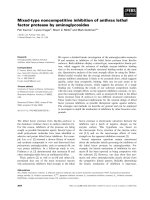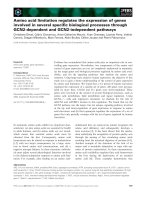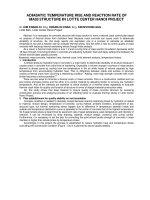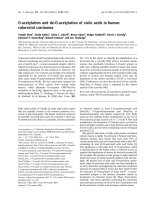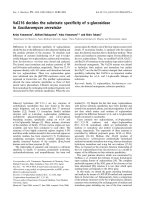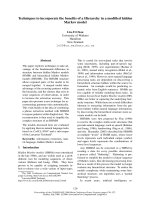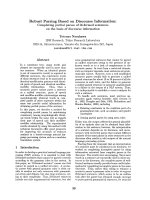Báo cáo khoa học: Effects on protease inhibition by modifying of helicase residues in hepatitis C virus nonstructural protein 3 pot
Bạn đang xem bản rút gọn của tài liệu. Xem và tải ngay bản đầy đủ của tài liệu tại đây (357.15 KB, 8 trang )
Effects on protease inhibition by modifying of helicase
residues in hepatitis C virus nonstructural protein 3
Go
¨
ran Dahl
1
, Anja Sandstro
¨
m
2
, Eva A
˚
kerblom
2
and U. Helena Danielson
1
1 Department of Biochemistry and Organic Chemistry, Uppsala University, Sweden
2 Department of Medicinal Chemistry, Organic Pharmaceutical Chemistry, Uppsala University, Sweden
The bifunctional nonstructural protein 3 (NS3,
EC 3.4.21.98) from hepatitis C virus (HCV) is an inter-
esting enzyme biochemically, and is of importance for
anti-HCV drug discovery. It has an N-terminal domain
that constitutes a serine protease with a typical chymo-
trypsin fold, and a C-terminal superfamily 2 DExH ⁄
D-box RNA helicase domain. Furthermore, the prote-
ase domain contains a structural zinc atom and needs
to interact with the viral nonstructural protein 4A
(NS4A) in order to be fully functional. The protease
activity of NS3 is responsible for cleaving the viral
polyprotein of HCV, whereas the helicase is responsi-
ble for unwinding double-stranded RNA. Thus, the
two enzyme activities of the NS3 protein are involved
in critical steps of viral replication, making them both
attractive anti-HCV drug targets (for reviews, see [1]
and [2]).
From a biochemical point of view, it is not clear
why the two enzymes are fused into a single protein.
The active sites of each of the enzymes are located in
the respective domains, and truncated variants of
NS3, containing either the protease or the helicase
alone, are functional on their own. However, the
truncated protease has slightly different kinetic prop-
erties and the helicase has a lower activity compared
with the full-length enzyme [3–5], suggesting that
there may be a functional justification for the con-
struction.
Nevertheless, for practical reasons, most researchers
working on the discovery of drugs against either of the
Keywords
full length; hepatitis C virus; inhibition;
nonstructural protein 3; protease
Correspondence
U. H. Danielson, Department of
Biochemistry and Organic Chemistry,
Uppsala University, BMC, Box576,
SE-751 23 Uppsala, Sweden
Fax: +46 18 558431
Tel: +46 18 4714545
E-mail:
(Received 4 May 2007, revised 17 August
2007, accepted 25 September 2007)
doi:10.1111/j.1742-4658.2007.06120.x
This study of the full-length bifunctional nonstructural protein 3 from hep-
atitis C virus (HCV) has revealed that residues in the helicase domain
affect the inhibition of the protease. Two residues (Q526 and H528), appar-
ently located in the interface between the S2 and S4 binding pockets of the
substrate binding site of the protease, were selected for modification, and
three enzyme variants (Q526A, H528A and H528S) were expressed, puri-
fied and characterized. The substitutions resulted in indistinguishable K
m
values and slightly lower k
cat
values compared to the wild-type. The K
i
val-
ues for a series of structurally diverse protease inhibitors were affected by
the substitutions, with increases or decreases up to 10-fold. The inhibition
profiles for H528A and H528S were different, confirming that not only did
the removal of the imidazole side chain have an effect, but also that minor
differences in the nature of the introduced side chain influenced the charac-
teristics of the enzyme. These results indicate that residues in the helicase
domain of nonstructural protein 3 can influence the protease, supporting
our hypothesis that full-length hepatitis C virus nonstructural protein 3
should be used for protease inhibitor optimization and characterization.
Furthermore, the data suggest that inhibitors can be designed to interact
with residues in the helicase domain, potentially leading to more potent
and selective compounds.
Abbreviations
HCV, hepatitis C virus; NS3, nonstructural protein 3; NS4A, nonstructural protein 4A.
FEBS Journal 274 (2007) 5979–5986 ª 2007 The Authors Journal compilation ª 2007 FEBS 5979
two enzyme activities use truncated forms of NS3 for
their studies. This has significant consequences. For
example, in the crystal structure of the truncated pro-
tease domain, the protease substrate binding site is
located on the surface of the protein, and it appears to
be shallow and featureless [6]. This has led researchers
to believe that the design of potent and selective inhib-
itors is not feasible, and many have apparently discon-
tinued their anti-HCV NS3 protease drug discovery
programmes. However, when the first and, so far, only
crystal structure of the full-length NS3 was published,
it revealed that the protease active site was situated in
the interface between the helicase and the protease
domains, creating a well-defined binding cleft (Fig. 1A)
[7]. Indeed, it appears that certain residues in the heli-
case domain may interact directly with substrates or
product-based inhibitors binding in this cleft [7]. As a
consequence, we have concluded that the full-length
protein is the most relevant model system for NS3.
Moreover, despite the lower yields and stabilities com-
pared with those obtained with the truncated protease,
it is the protein that has been used in all of our studies
of the NS3 protease [8–13].
Nevertheless, we are interested in determining the
functional importance of the helicase domain for the
activity and inhibition of the protease, and have
focused on the identification of specific helicase resi-
dues which may be involved. In the crystal structure of
the full-length enzyme, the C-terminus is located in the
substrate binding site and the helicase clearly interacts
with the C-terminus of NS3 (Fig. 1B) [7]. By structural
modelling of an inhibitor binding to full-length NS3,
we found that most of the contacts were with the pep-
tide backbone, but that the side chains of residues
Q526 and H528 appeared to interact directly with the
P2 and P4 residues of the inhibitor [10]. Q526 and
H528 are conserved between different strains of HCV
[9], supporting the hypothesis that they may play an
important role in the functionality of NS3.
In order to experimentally determine the importance
of these residues, we have substituted the side chains
of these residues for side chains with other functional
properties, and have analysed how this affects protease
activity and inhibition. For the analysis of modified
inhibition characteristics, a set of 11 inhibitors with
varying structure, mechanism and potency was used
(Fig. 2). BILN 2061 was the first HCV NS3 protease
inhibitor to reach clinical trials [14], but was later with-
drawn because of cardiac toxicity in rhesus monkeys
[15]. Nevertheless, it is a useful model compound as it
is one of the most potent inhibitors of HCV NS3
today, and is a macrocyclic compound, in contrast to
other inhibitors used here. VX-950 was the second
inhibitor to reach clinical trials and is therefore also a
useful reference compound [16]. It is a linear mecha-
nism-based inhibitor with an electrophilic C-terminus,
and is thus different mechanistically from BILN 2061
and the other compounds studied here. The other
inhibitors were selected from the compounds previ-
ously tested against the wild-type enzyme. They
include tri- and tetrapeptides with either a carboxylic
acid or an acyl sulfonamide as their C-terminus [11–
13], and hexapeptides with P2 and P4 residues of dif-
ferent polarity and size [8,10].
H528
AB
Q526
D81
H57
S139
Fig. 1. Structure of full-length HCV NS3.
(A) Complete HCV NS3 with the protease
domain (red), helicase domain (blue) and
NS4A cofactor fused to the N-terminus
(green) (PDB: 1CU1) [7]. The structural zinc
atom in the protease domain and a phos-
phate group in the helicase domain are also
visible. The interface region between the
helicase and the protease domains is
framed and shown in detail in (B). The cata-
lytic triad, H57, D81 and S139, in the pro-
tease domain, and the conserved helicase
residues, Q526 and H528, are shown in a
ball-and-stick representation. The blue
strand represents the C-terminus of NS3,
and shows the substrate binding site of the
protease.
Hepatitis C virus NS3 protease ⁄ helicase G. Dahl et al.
5980 FEBS Journal 274 (2007) 5979–5986 ª 2007 The Authors Journal compilation ª 2007 FEBS
Fig. 2. Structures of the studied inhibitors. The arrows indicate the a-carbon of the P1 residue of the inhibitor. The P2, P3, P4, P5 and P6
side chains can be deduced from the nomenclature by Schechter and Berger [20].
G. Dahl et al. Hepatitis C virus NS3 protease ⁄ helicase
FEBS Journal 274 (2007) 5979–5986 ª 2007 The Authors Journal compilation ª 2007 FEBS 5981
Results
Strategy and enzyme production
In order to determine the functional significance of the
side chains of helicase residues hypothesized to interact
directly with the substrate or inhibitors of the protease,
Q526 and H528 were substituted for residues for side
chains with different interaction characteristics. Three
single mutants, coding for the enzyme variants Q526A,
H528A and H528S, were created. The alanine substitu-
tion replaces the original side chain with a small
hydrophobic moiety, whereas the serine substitution
also introduces alternative hydrogen bonding capabili-
ties.
Full-length Q526A, H528A and H528S HCV NS3
were successfully constructed, expressed and purified.
Expression resulted in around 150–200 lg of enzyme
per litre of cell culture for all variants and the wild-
type. Purities were over 98% in all cases, as judged by
the single band on a silver-stained SDS ⁄ PAGE gel
(Fig. 3). An automatic chromatographic procedure
gave a highly reproducible purification.
Kinetic characterization of NS3 protease variants
The three substitutions in the helicase domain of NS3
did not influence the K
m
values significantly, but k
cat
values were reduced (Table 1). Assuming a normal dis-
tribution, the wild-type has a significantly higher k
cat
value compared with the helicase variants at a 95%
confidence level.
Inhibition of NS3 protease variants
The effect of changes in the helicase residues on the
inhibition of the protease was investigated for the three
variants and a series of inhibitors. Inhibition constants
(K
i
) were determined for all variants and inhibitors
(Fig. 4).
The data showed that the substitutions of Q526 and
H528 did not generally have a large or consistent effect
on the inhibition, but there were some notable effects
and trends. The Q526A and H528A substitutions had
little impact on the inhibition of the enzyme by
BILN 2061, but the H528S substitution reduced the
potency of the inhibitor. As a result, the K
i
value for
BILN 2061 differed 10-fold depending on whether the
residue in position 528 was alanine or serine. A similar
profile was also seen with compound 9, the second
most potent inhibitor. By contrast, VX-950 was not
affected by any of the investigated substitutions.
The effect of substituting either Q526 or H528 was
found to be more diverse for the less potent com-
pounds. The inhibition by compounds 4 and 6 was not
affected to any large extent by any of the substitutions,
whereas compounds 2 and 5 became more effective for
all variants. The H528A substitution decreased the K
i
values for compounds 1 and 3, but the Q526A and
H528S substitutions had no effect. All substitutions
reduced the inhibition by compound 7, and both
Q526A and H528A reduced it for compound 8.It
should be noted that the differences between the values
were larger than those deduced from the differences in
bar lengths in the logarithmic graph.
Discussion
This study has shown that residues in the helicase
domain of full-length NS3 from HCV can directly
influence the protease. Modifications of the side chains
of two residues (Q526 and H528) were found to influ-
ence the effect of some protease inhibitors. The K
m
123456
97 kDa
66
45
30
20.1
14.4
Fig. 3. Purification of HCV NS3 protease. A silver-stained
SDS ⁄ PAGE gel from a typical purification procedure (in this case
the H528A variant): Lane 1, immobilized ion affinity chromatography
(IMAC) flow-through; lane 2, IMAC eluate; lane 3, IMAC eluate
after buffer change; lane 4, PolyU flow-through; lane 5, PolyU elu-
ate; lane 6, molecular weight marker (LMW-SDS Marker kit, GE
Healthcare).
Table 1. Kinetic parameters for all enzyme variants studied. The
standard deviations from three determinations are provided.
Kinetic
parameter
Enzyme variant
Wild-type Q526A H528A H528S
K
m
(lM) 0.27 ± 0.06 0.38 ± 0.17 0.29 ± 0.07 0.44 ± 0.30
k
cat
(s
)1
) 0.53 ± 0.03 0.30 ± 0.04 0.32 ± 0.02 0.37 ± 0.04
k
cat
⁄ K
m
(lM
)1
Æs
)1
)
1.96 ± 0.45 0.79 ± 0.37 1.10 ± 0.28 0.84 ± 0.58
Hepatitis C virus NS3 protease ⁄ helicase G. Dahl et al.
5982 FEBS Journal 274 (2007) 5979–5986 ª 2007 The Authors Journal compilation ª 2007 FEBS
and k
cat
⁄ K
m
values for the enzyme variants were indis-
tinguishable from those of the wild-type, even though
the k
cat
values were significantly lower. However, this
is not considered to be of great importance and could
be a result of differences in the active enzyme concen-
tration.
The effect of changing residues in the helicase
domain on inhibition was dependent on both the sub-
stitution and the inhibitor. Substitution of Q526 with
alanine had only minor effects, despite earlier specula-
tions that this residue is located in the interface
between the S2 and S4 binding pockets of the full-
length enzyme, and therefore would be critical for
interaction with product-based inhibitors [7,10]. Substi-
tuting H528 with alanine resulted in increased inhibi-
tion for all compounds except three, whose inhibition
was more or less unchanged. The increase was largest
for compounds with a P4 side chain. Under the present
conditions (pH 7.4), H528 is expected to be essentially
uncharged and to act either as a hydrogen bond donor,
interacting with the carbonyl oxygen of the P4 residue
on the inhibitor, or as a hydrogen bond acceptor for
the P4 NH of the inhibitor. Although some of the
inhibitors were only tripeptides, they all had at least
the equivalent of a P4 carbonyl group, and the substi-
tution of H528 with alanine or serine could thus be
expected to weaken the inhibition, but not to increase
it. Apparently, other interactions play a significant
role, where, for example, the hydrophobic alanine resi-
due contributes more than a potential hydrogen bond
from the histidine. When H528 was replaced with ser-
ine, the effect was more varied; both enhanced and
reduced inhibition were detected. However, compounds
lacking a P4 residue and containing large P2 side
chains were affected the most by this substitution, lead-
ing to reduced potencies. This effect became less and
less pronounced as the overall potency of the inhibitors
decreased. It is not clear why the nature of the residue
at position 528 results in such different effects, espe-
cially for BILN 2061, but these observations imply that
the initial structural model [10] does not adequately
describe the forces involved. It should be noted that,
even though a 10-fold change in K
i
is significant, the
change in binding energy is small and equal to approx-
imately the loss of a hydrogen bond [17].
Drug discovery is a technique in which modified
variants of enzymes are often used in order to increase
stability, yield or other parameters to produce an effi-
cient process. However, it is critical that the modifica-
tion does not compromise the information obtained
when using the variant for drug discovery purposes.
Although the data presented here are based on a lim-
ited number of compounds and only two helicase resi-
dues, the experimental observations indicate that the
helicase can influence protease inhibitors. Therefore,
the use of truncated NS3, containing only the protease
domain, for the identification and optimization of
HCV NS3 protease inhibitors is a procedure that may
be inappropriate. The data also suggest that inhibitors
can be designed to interact with residues in the helicase
domain, potentially leading to more potent and selec-
tive compounds.
Conclusion
The strategy used in this study has demonstrated that
specific amino acids in the helicase of full-length HCV
NS3 can influence the inhibition of the protease. As a
consequence, anti-HCV protease drug discovery using
full-length HCV NS3 as a model system for inhibition
studies may be more appropriate than using the trun-
cated protease. In addition, protease inhibitor design
can make use of the helicase domain as a novel anchor
point for inhibitors.
Fig. 4. Effect of HCV NS3 helicase domain
substitutions Q526A, H528A and H528S on
the potency of NS3 protease inhibitors.
Error bars represent the standard deviations.
The scale on the y-axis ranges from 10 p
M
(top) to 10 lM (bottom) on a logarithmic
scale. Blue, wild-type; red, Q526A; yellow,
H528A; green, H528S.
G. Dahl et al. Hepatitis C virus NS3 protease ⁄ helicase
FEBS Journal 274 (2007) 5979–5986 ª 2007 The Authors Journal compilation ª 2007 FEBS 5983
Experimental procedures
PCR
Mutations in the helicase domain of the previously used
gene construct for full-length HCV NS3 [9] were introduced
by PCR using Q526A forward primer (5¢-TCCCGTGTGT
GCAGACCATCTTGAAT-3¢), H528A forward primer
(5¢-TCCCGTGTGTCAAGACGCTCTTGAAT-3¢) or H 52 8S
forward primer (5¢-TCCCGTGTGTCAAGACTCTCTTG
AAT-3¢) and reverse primer (5¢-AGTCCCGGGGTGTT
CATGTATGCTC-3¢). Each PCR vial contained 50 ng of
template DNA, 0.2 mm dNTPs, 0.2 lm forward primer,
0.2 lm reverse primer (Thermo Electron GmbH, Ulm, Ger-
many) and 1.25 U Pfu Turbo DNA polymerase (Strata-
gene, La Jolla, CA, USA) in 50 lL Pfu Buffer [200 mm
Tris ⁄ HCl pH 8.8, 20 mm MgSO
4
, 100 mm KCl, 100 mm
(NH
4
)
2
SO
4
, 1% Triton X-100, 1 mgÆmL
)1
nuclease free
BSA (Stratagene)]. The primers were phosphorylated at the
5¢-end to promote recircularization. The vials were sub-
jected to 1 min of melting at 95 °C, 1 min of annealing at
73 °C and 15 min of extension at 72 °C in 25 cycles using a
thermal cycler (GeneAmp PCR system 2400, Perkin-Elmer,
Boston, MA, USA). After this, 20 U DpnI restriction
enzyme (New England Biolabs, Beverly, MA, USA) was
added and the vials were left at 37 °C for 1 h. The DNA
was then purified on a 1% Tris, borate, EDTA agarose gel,
and fragments corresponding to the PCR products were cut
out and purified using the GeneClean gel extraction kit
(Qbiogene, Illkirch Cedex, France). The purified PCR prod-
uct was then blunt-end ligated using the T4 rapid DNA
ligation kit (Roche Diagnostics Scandinavia AB, Bromma,
Sweden) and transformed to thermocompetent TOP10 cells.
The DNA was sequenced using a Mega BACE 1000
sequencer (GE Healthcare, Uppsala, Sweden).
Expression and purification
The expression and purification of HCV NS3 variants were
performed essentially as described previously [9]. That is,
6 · 500 mL TOP10 cells with A
600
¼ 0.7 were induced
with 0.002% (w ⁄ v) l-(+)-arabinose overnight at 21 °C,
150 r.p.m. The cells were then harvested and resuspended
in lysation buffer [25 mm Hepes pH 7.6, 0.3 m NaCl, 20%
glycerol, 10 mm b-mercaptoethanol and 0.1% Chaps (Ana-
trace, Maumee, OH, USA)] and 2 lgÆmL
)1
DNAse I
(Roche Diagnostics Scandinavia AB). Lysation was initi-
ated by adding 1 mgÆmL
)1
lysozyme (Sigma-Aldrich Swe-
den AB, Stockholm, Sweden), and thereafter the cells were
sonicated. The lysate was centrifuged at 25 000 g for
40 min, and the cleared supernatant was loaded on to a
10 mL chelating Sepharose fast flow gel (GE Healthcare)
loaded with Ni
2+
, and washed with buffer A (50 mm Hepes
pH 7.6, 0.3 m NaCl, 26% glycerol, 10 mm b-mercaptoetha-
nol and 0.1% Chaps), buffer A supplemented with 1 m
NaCl and, finally, buffer A supplemented with 50 mm imid-
azole, before partially purified enzyme was eluted with buf-
fer A supplemented with 250 mm imidazole. The eluted
fractions with highest absorbance at 280 nm were pooled
and the buffer was changed to buffer B [25 mm Hepes
pH 7.6, 0.2 m NaCl, 20% glycerol, 10 mm b-mercaptoetha-
nol and 0.1% n-octyl-b-d-glucoside (Anatrace)] using a
HiTrap desalting column (GE Healthcare). The sample was
loaded on to a 2.5 mL PolyU gel (GE Healthcare), and the
gel was washed with buffer B before purified enzyme was
finally eluted with buffer B supplemented with 1 m NaCl.
All chromatographic steps were performed with an A
¨
KTA
Explorer (GE Healthcare). The eluted fractions with highest
absorbance at 280 nm were pooled and stored at ) 80 °C.
The protein concentration was determined using a Brad-
ford-based assay (Bio-Rad, Sundbyberg, Sweden), and the
purity was estimated with SDS ⁄ PAGE using the PHAST
system and 8–25% precast PHAST gels and silver staining
(GE Healthcare).
Enzymatic characterization
Protease activity was measured as described previously
[9]. That is, the hydrolysis of a depsipeptide substrate,
Ac-Asp-Glu-Asp(EDANS)-Glu- Glu-Abu-w-[COO]Al a-Ser-
Lys(DABCYL)-NH
2
(AnaSpec, San Jose, CA, USA), was
recorded continuously over time with a fluorescence plate
reader (Fluoroskan Ascent Labsystems, Stockholm, Swe-
den). Each sample well contained 276.5 lL assay buffer
(50 mm Hepes pH 7.5, 10 mm dithiothreitol, 40% (w ⁄ v)
glycerol, 0.1% n-octyl-b-d-glucoside), 9.25 lL dimethylsulf-
oxide, 0.75 lLof10mm peptide cofactor KKGSVVIV-
GRIVLSGK in dimethylsulfoxide and 3.5 lLof6lgÆmL
)1
NS3 (1 nm final concentration), and was incubated at 30 °C
for 10 min before the reaction was started by the addition
of 10 lL substrate to a final concentration between 0.25
and 4 lm. All measurements were performed in triplicate.
K
m
and k
cat
values were estimated by fitting the Michaelis–
Menten equation to the data by simulated annealing
(GOSA, Bio-Log, Ramonville, France). k
cat
⁄ K
m
values were
calculated from the estimated k
cat
and K
m
values.
Inhibitors and inhibition measurements
Eleven inhibitors were used in this study (Fig. 2). They
included the clinical compounds BILN 2061 [14] and VX-
950 [16], compounds 2, 3, 4, 5 (compounds 16, 4, 9 and 1,
respectively, in [10]), compound 6 (compound 18a in [13]),
compounds 7, 8, 9 (compound 20, 29 and 31, respectively,
in [12]) and the commercially available reference compound
1 (Product no. N-1725, Bachem, Weil am Rein, Germany)
(entry 14 in Table 4 in [18]).
The inhibitors were dissolved in dimethylsulfoxide and
preincubated with enzyme and NS4A cofactor at 30 °C
for 10 min in the same buffer conditions as stated for the
Hepatitis C virus NS3 protease ⁄ helicase G. Dahl et al.
5984 FEBS Journal 274 (2007) 5979–5986 ª 2007 The Authors Journal compilation ª 2007 FEBS
activity assay. The reaction was started by the addition of
10 lL substrate to a final concentration of 0.5 lm. Pilot
measurements over a large concentration range were per-
formed in order to estimate IC
20
and IC
80
. Six inhibitor
concentrations between IC
20
and IC
80
with constant enzyme
and substrate amounts were used. All measurements were
performed in triplicate. The K
i
and V
max
values were esti-
mated by fitting Eqn (1) (adapted from [19]) to the data
using simulated annealing (GOSA, Bio-Log).
V ¼
V
max
[E]
½S
2
Â
ffiffiffiffiffiffiffiffiffiffiffiffiffiffiffiffiffiffiffiffiffiffiffiffiffiffiffiffiffiffiffiffiffiffiffiffiffiffiffiffiffiffiffiffiffiffiffiffiffiffiffiffiffiffiffiffiffiffiffiffiffiffiffiffiffiffiffiffiffiffiffiffiffiffi
1
K
m
K
i
þ
ð½IÀ½EÞ
ðK
m
þ½SÞ
0
@
1
A
2
þ
4 ½E
ðK
m
þ½SÞÂ
K
m
K
i
v
u
u
u
t
2
6
4
À
1
K
m
K
i
þ
ð½IÀ½EÞ
ðK
m
þ½SÞ
0
@
1
A
3
5
ð1Þ
Acknowledgements
We would like to thank Gun Stenberg for her help in
primer design, and Robert Ro
¨
nn and Pernilla O
¨
rtqvist
(Department of Medicinal Chemistry, Pharmaceutical
Organic Chemistry, Uppsala University, Sweden) for
compounds 6, 7, 8 and 9. We would also like to thank
Boehringer Ingelheim for the kind gift of BILN 2061
and the VIRGIL DrugPharm Team for VX-950. This
work was conducted with support from the VIRGIL
European Union Network of Excellence.
References
1 De Francesco R & Migliaccio G (2005) Challenges and
successes in developing new therapies for hepatitis C.
Nature 436, 953–960.
2 Frick DN (2007) The hepatitis C virus NS3 protein: a
model RNA helicase and potential drug target. Curr
Issues Mol Biol 9, 1–20.
3 Sali DL, Ingram R, Wendel M, Gupta D, McNemar C,
Tsarbopoulos A, Chen JW, Hong Z, Chase R, Risano
C et al. (1998) Serine protease of hepatitis C virus
expressed in insect cells as the NS3 ⁄ 4A complex.
Biochemistry 37, 3392–3401.
4 Frick DN, Rypma RS, Lam AM & Gu B (2004) The
nonstructural protein 3 protease ⁄ helicase requires an
intact protease domain to unwind duplex RNA effi-
ciently. J Biol Chem 279, 1269–1280.
5 Zhang C, Cai Z, Kim YC, Kumar R, Yuan F, Shi PY,
Kao C & Luo G (2005) Stimulation of hepatitis C virus
(HCV) nonstructural protein 3 (NS3) helicase activity
by the NS3 protease domain and by HCV RNA-depen-
dent RNA polymerase. J Virol 79, 8687–8697.
6 Kim JL, Morgenstern KA, Lin C, Fox T, Dwyer
MD, Landro JA, Chambers SP, Markland W, Lepre
CA, O’Malley ET et al. (1996) Crystal structure of
the hepatitis C virus NS3 protease domain complexed
with a synthetic NS4A cofactor peptide. Cell 87, 343–
355.
7 Yao N, Reichert P, Taremi SS, Prosise WW & Weber
PC (1999) Molecular views of viral polyprotein process-
ing revealed by the crystal structure of the hepatitis C
virus bifunctional protease-helicase. Structure 7, 1353–
1363.
8 Johansson A, Hubatsch I, A
˚
kerblom E, Lindeberg G,
Winiwarter S, Danielson UH & Hallberg A (2001) Inhi-
bition of hepatitis C virus NS3 protease activity by
product-based peptides is dependent on helicase
domain. Bioorg Med Chem Lett 11, 203–206.
9 Poliakov A, Hubatsch I, Shuman CF, Stenberg G &
Danielson UH (2002) Expression and purification of
recombinant full-length NS3 protease-helicase from a
new variant of hepatitis C virus. Protein Expr Purif 25,
363–371.
10 Johansson A, Poliakov A, A
˚
kerblom E, Lindeberg G,
Winiwarter S, Samuelsson B, Danielson UH & Hallberg
A (2002) Tetrapeptides as potent protease inhibitors of
hepatitis C virus full-length NS3 (protease-helicase ⁄
NTPase). Bioorg Med Chem 10, 3915–3922.
11 Johansson A, Poliakov A, A
˚
kerblom E, Wiklund K,
Lindeberg G, Winiwarter S, Danielson UH, Samuelsson
B & Hallberg A (2003) Acyl sulfonamides as potent
protease inhibitors of the hepatitis C virus full-length
NS3 (protease-helicase ⁄ NTPase): a comparative study
of different C-terminals. Bioorg Med Chem 11, 2551–
2568.
12 Ro
¨
nn R, Sabnis YA, Gossas T, A
˚
kerblom E, Danielson
UH, Hallberg A & Johansson A (2006) Exploration of
acyl sulfonamides as carboxylic acid replacements in
protease inhibitors of the hepatitis C virus full-length
NS3. Bioorg Med Chem 14, 544–559.
13 O
¨
rtqvist P, Peterson SD, A
˚
kerblom E, Gossas T, Sabnis
YA, Fransson R, Lindeberg G, Danielson UH, Karle
´
n
A & Sandstro
¨
m A (2006) Phenylglycine as a novel P2
scaffold in hepatitis C virus NS3 protease inhibitors.
Bioorg Med Chem 15, 1448–1474.
14 Lamarre D, Anderson PC, Bailey M, Beaulieu P, Bolger
G, Bonneau P, Bo
¨
s M, Cameron DR, Cartier M, Cord-
ingley MG et al. (2003) An NS3 protease inhibitor with
antiviral effects in humans infected with hepatitis C
virus. Nature 426, 186–189.
15 Reiser M, Hinrichsen H, Benhamou Y, Reesink HW,
Wedemeyer H, Avendano C, Riba N, Yong CL,
Nehmiz G & Steinmann GG (2005) Antiviral efficacy of
NS3-serine protease inhibitor BILN-2061 in patients
with chronic genotype 2 and 3 hepatitis C. Hepatology
41, 832–835.
16 Perni RB, Almquist SJ, Byrn RA, Chandorkar G,
Chaturvedi PR, Courtney LF, Decker CJ, Dinehart K,
Gates CA, Harbeson SL et al. (2006) Preclinical profile
of VX-950, a potent, selective, and orally bioavailable
G. Dahl et al. Hepatitis C virus NS3 protease ⁄ helicase
FEBS Journal 274 (2007) 5979–5986 ª 2007 The Authors Journal compilation ª 2007 FEBS 5985
inhibitor of hepatitis C virus NS3–4A serine protease.
Antimicrob Agents Chemother 50, 899–909.
17 Fersht A (1999) Chapter 11. In Structure and Mecha-
nism in Protein Science: a Guide to Enzyme Catalysis
and Protein Folding (Russel Julet M, ed.), p. 338.
W.H. Freeman Co., New York, NY.
18 Ingallinella P, Altamura S, Bianchi E, Taliani M,
Ingenito R, Cortese R, De Francesco R, Steinku
¨
hler
C & Pessi A (1998) Potent peptide inhibitors of
human hepatitis C virus NS3 protease are obtained
by optimizing the cleavage products. Biochemistry 37,
8906–8914.
19 Morrison JF (1969) Kinetics of the reversible inhibition
of enzyme-catalysed reactions by tight-binding inhibi-
tors. Biochim Biophys Acta 185, 269–286.
20 Schechter I & Berger A (1967) On the size of the active
site in proteases. I. Papain. Biochem Biophys Res
Commun 27, 157–162.
Hepatitis C virus NS3 protease ⁄ helicase G. Dahl et al.
5986 FEBS Journal 274 (2007) 5979–5986 ª 2007 The Authors Journal compilation ª 2007 FEBS
